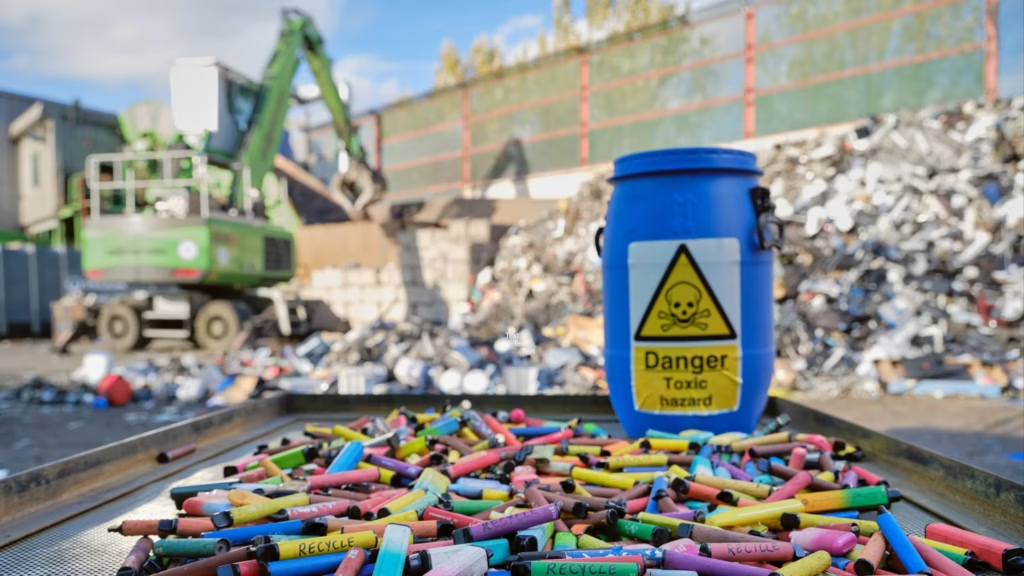
Vaping has exploded in popularity among young people, but it’s fueling a vaping pollution crisis creating a new wave of electronic and plastic waste that threatens the environment. As the shift from smoking to vaping continues, we are witnessing a transition from cigarette-related pollution to a new form of waste—one that involves plastic, electronics, and toxic chemicals. Understanding how cigarette pollution impacted the environment and how vaping is now progressing as a new source of pollution is crucial to addressing this growing issue.
The Shift from Cigarettes to Vapes: Changing Forms of Pollution
For decades, cigarette butts were one of the most common forms of litter worldwide. Composed of non-biodegradable filters, they clogged streets, parks, and waterways, releasing toxic chemicals into the environment. According to environmental organizations, cigarette butts accounted for an estimated 30-40% of all litter collected in coastal cleanups. These small, seemingly insignificant pieces of trash contributed heavily to soil and water contamination and posed a significant threat to wildlife.
As smoking rates have declined and vaping has gained popularity, a new pollution crisis has emerged. Unlike cigarette butts, which eventually degrade, vape waste has created a vaping pollution crisis, filling landfills with plastics, lithium-ion batteries, and chemical-laden pods that persist for far longer. This shift has created an alarming trend where we have swapped one form of pollution for another, trading cigarette filters for electronic waste and non-recyclable materials.
The Rise of Disposable Vapes and E-Waste
One of the most concerning trends in vaping is the rise of disposable devices. Unlike traditional refillable e-cigarettes, disposable vapes are designed for short-term use and are often discarded carelessly. These devices contain a mix of plastic, metal, and lithium-ion batteries, making them difficult to recycle and leading to an exponential increase in e-waste.
A recent report found that over 5 million disposable vapes are thrown away each week in the UK alone. The lithium used in these devices is a finite resource, and its extraction comes with significant environmental costs. However, without proper disposal methods or take-back programs, much of this material is wasted, adding to the mounting global e-waste crisis.
Young people, in particular, tend to gravitate toward disposable vapes because they are easier to conceal. Their small size, lack of need for maintenance, and ability to be discreetly discarded make them a more attractive option for underage users and those trying to avoid detection. Unfortunately, this convenience factor also leads to more frequent littering and environmental damage.
Plastic and Chemical Contamination
Aside from e-waste, vape cartridges and pods contribute to plastic pollution. Unlike cigarette butts, which are primarily composed of paper and cellulose acetate, vape pods contain rigid plastic components that do not easily degrade. When disposed of improperly, these plastics leach into the environment, releasing microplastics and harmful chemicals into soil and waterways. Furthermore, residual nicotine and heavy metals can contaminate ecosystems, posing risks to wildlife and human health.
What Can Be Done?
As vaping continues to rise, there are several steps that can be taken to mitigate its environmental impact:
- Banning disposable vapes: Some countries and cities are considering restrictions on single-use vapes to reduce waste.
- Improved recycling programs: Manufacturers must implement take-back and recycling programs for used devices and batteries.
- Raising consumer awareness: Educating vapers on proper disposal methods can help curb littering and pollution.
- Encouraging refillable options: Switching to rechargeable and refillable vapes can significantly reduce waste compared to disposables.
The transition from cigarette smoking to vaping has led to a new wave of environmental challenges. While cigarette pollution created its own set of problems, vaping has introduced a more complex waste issue involving electronics, plastics, and toxic chemicals. Without significant changes in how these products are produced, used, and discarded, vaping will continue to contribute to the global waste crisis. Consumers, manufacturers, and policymakers must collaborate to develop sustainable solutions and prevent this trend from escalating further.
Sources:
- Maloney, Jennifer. “The Overlooked Environmental Impact of Vaping.” TIME, 14 July 2023, time.com/6293772/disposable-vapes-plastic-waste.
- Gaiha, Shivani M., et al. “Youth Engagement and Perceptions of Disposable E-Cigarettes: A Qualitative Study.” Nicotine & Tobacco Research, vol. 25, no. 3, 2023, pp. 467–475, pmc.ncbi.nlm.nih.gov/articles/PMC10040067


